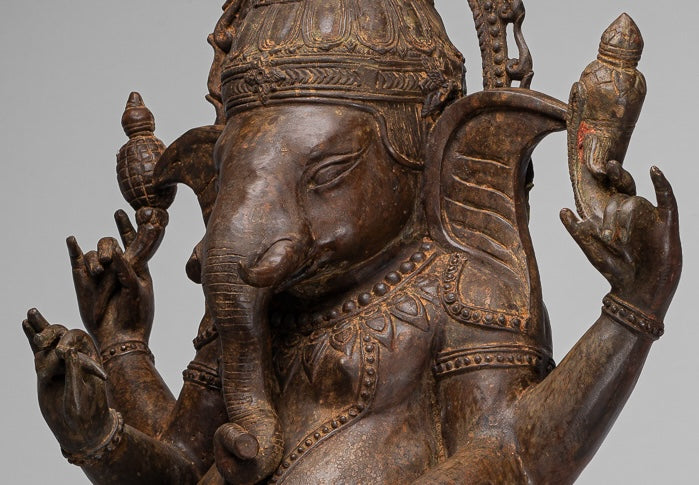
The Importance of Dancing Ganesha in Hinduism in Thailand
In the cultural and religious tapestry of Thailand, the presence of Hindu deities reflects a rich history of cultural exchange and syncretism. Among these deities, Ganesha, the elephant-headed god, holds a special place.
Known as the remover of obstacles, the patron of arts and sciences, and the deity of beginnings, Ganesha is venerated not only in India but also in various Southeast Asian countries, including Thailand. A particularly fascinating and significant representation of Ganesha in Thai Hinduism is the Dancing Ganesha.
This blog post explores the meaning, origins, iconography, and cultural importance of Dancing Ganesha in Thailand, highlighting his unique role in Thai spiritual and artistic traditions.
Who is Ganesha?
Ganesha, also known as Ganapati, Vinayaka, and Pillaiyar, is one of the most widely worshipped deities in Hinduism. Recognizable by his elephant head and large belly, Ganesha is revered as the god of wisdom, prosperity, and good fortune. He is traditionally invoked at the beginning of rituals and ceremonies to remove obstacles and ensure success.
The Dancing Ganesha: Symbolism and Meaning
The Dancing Ganesha, or Nritya Ganapati, is a dynamic and joyful depiction of Ganesha engaged in dance. This form symbolizes several important aspects:
-
Joy and Celebration: Dancing Ganesha represents joy, celebration, and the cosmic dance of life. His dance signifies the rhythm and harmony of the universe, emphasizing the importance of joy in spiritual practice.
-
Art and Creativity: As the patron of arts, Ganesha's dance highlights his association with creativity, music, and the performing arts. It reflects the belief that artistic expression is a divine gift and a means of connecting with the divine.
-
Overcoming Obstacles: The dance of Ganesha also symbolizes the idea of overcoming obstacles with grace and agility. It conveys the message that challenges in life can be approached with a positive and dynamic attitude.
Historical Context and Spread to Thailand
The worship of Ganesha and the depiction of Dancing Ganesha can be traced back to ancient India. Over time, as Indian culture and religion spread to Southeast Asia through trade, migration, and the influence of Hindu-Buddhist kingdoms, Ganesha became a significant figure in the region.
In Thailand, the presence of Ganesha dates back to the Dvaravati period (6th to 11th centuries) and the Khmer Empire (9th to 15th centuries), when Hinduism and Buddhism were both practiced. The cultural exchange during these periods led to the integration of Hindu deities into Thai religious practices. Ganesha, with his universal appeal, was adopted and adapted into Thai culture, where he remains a prominent figure.
Iconography of Dancing Ganesha in Thailand
The Dancing Ganesha is depicted with distinct iconographic features that blend Indian and Thai artistic traditions:
-
Dynamic Posture: Dancing Ganesha is typically shown in a dynamic dance pose, with one leg raised and multiple arms gracefully positioned to convey movement and rhythm.
-
Attributes and Symbols: He holds various attributes in his hands, such as a trident (trishula), an axe (parashu), a lotus, and a sweet (modaka), each symbolizing different aspects of his divine powers.
-
Ornate Adornments: The depiction often includes elaborate jewelry, flowing garments, and a detailed headdress, reflecting the intricate style of Thai art.
-
Facial Expression: Ganesha’s face, with its serene and joyful expression, embodies the bliss and contentment that come from divine wisdom and spiritual practice.
Cultural and Religious Significance in Thailand
The Dancing Ganesha holds a special place in Thai religious and cultural life, influencing various aspects:
-
Temples and Shrines: Statues and images of Dancing Ganesha are found in Hindu temples and shrines across Thailand. Devotees offer prayers, flowers, and incense to seek his blessings for success and the removal of obstacles.
-
Festivals and Celebrations: Ganesha is celebrated during festivals such as Ganesh Chaturthi, where his statues are paraded through the streets, accompanied by music and dance. These celebrations highlight his role as a deity of joy and creativity.
-
Influence on Arts: Ganesha’s association with arts and learning makes him a beloved figure among artists, musicians, and students in Thailand. His blessings are sought before performances, exams, and new ventures, reflecting his role as a patron of arts and wisdom.
-
Syncretism with Buddhism: In Thailand, where Buddhism is the predominant religion, Ganesha is often integrated into Buddhist practices. Temples dedicated to both Buddhist and Hindu deities reflect the syncretic nature of Thai spirituality, where Ganesha is revered alongside Buddha and other Buddhist figures.
Conclusion
The Dancing Ganesha embodies the fusion of spirituality, art, and culture in Thailand, reflecting the deep connections between Hindu and Buddhist traditions. His joyful dance serves as a reminder of the importance of creativity, celebration, and overcoming obstacles with grace and wisdom.
As a symbol of auspicious beginnings and a patron of the arts, Dancing Ganesha continues to inspire devotion and creativity in Thailand, enriching the spiritual and cultural landscape of the nation.
Through his dynamic presence, Dancing Ganesha bridges the ancient and the modern, the Indian and the Thai, offering a timeless source of inspiration and blessings to all who seek his grace.


















